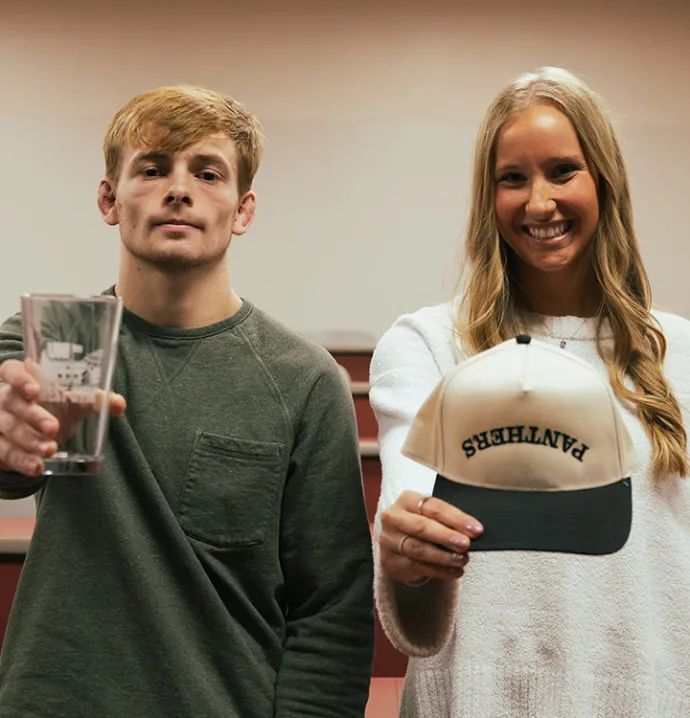Can sustainable business practices be profitable?
Can sustainable business practices be profitable?
It’s no secret that business decisions are largely driven by the bottom line. Historically, that’s how sustainability has been viewed, as a financially driven concept, said Scott Blankman (Accounting ‘89), director for energy and air programs at Clean Wisconsin, a nonprofit environmental policy advocacy organization.
In short: Does sustainability make me money? More recently, that question is becoming easier to answer.
Blankman said it’s simpler to find cost-effective sustainable solutions today compared to even a decade ago. Businesses are also changing their perception of sustainability. They realize the most profitable path forward may not be the most effective one.
“When you’re a for-profit business, profitability always exists, but there is a recognition, and many companies have come with goals that realize there is a responsibility to the environment,” Blankman said. “You’re starting to see more and more companies take a look at the tangible and nontangible benefits associated with more renewables or sustainability-driven initiatives.”
That certainly holds up to scrutiny. According to a 2017 study from the Massachusetts Institute of Technology and the Boston Consulting Group, 90% of executives surveyed see sustainability as important, and 60% of companies surveyed actually had a sustainability strategy.
But to effectively implement sustainable practices, businesses have to make a business case, not an ethical one, the study said.
In essence, make sustainability profitable.
Take, for example, the energy sector, where Blankman worked for 13 years at Alliant Energy. Over the past decade or so, renewable energy has started to become cheaper, effectively pushing more businesses to environmentally friendly power sources.
At first, the popular choice was wind energy when turbines were being constructed across the Midwest. More recently, there’s been a rise in solar power, which Blankman said has seen a 90% decrease in cost in the past five years. The improvement of battery storage for these renewable sources has been dramatic as well, he said, as he’s seen prices drop to a fourth of what they were a decade ago. The International Renewable Energy Agency, which
has 150 member countries, predicted renewable energy technologies will be competitive on price with fossil fuels by 2020.
Because of cheaper energy alternatives and consumer and investor pressure to invest in renewables, more private businesses are partnering with independent energy contractors who focus on sustainability, Blankman said.
Utilities have followed suit, putting renewable energy squarely in their future plans.
Blankman added there’s a long-term cost-effectiveness to environmentally friendly energy as well. Businesses are realizing that sustainability could mean avoiding steep costs due to future environmental changes. That’s why many utilities are releasing measurable sustainability goals, like becoming coal-free by 2050.
“Businesses understand that becoming sustainable will help them lower costs in the future,” Blankman said. “That’s avoiding higher insurance rates and environmental impacts on their business. Look at the agricultural community in Iowa and all of the flooding happening. Those are examples of how businesses could be impacted.”
Blankman anticipates the sustainable trend continuing in the energy sector as renewable energy costs continue to drop and investors push for greener goals. There’s a huge opportunity for businesses to get the best of both worlds — going green while also reaping benefits to the bottom line.
“I think from a sustainability perspective, there is a significant opportunity ahead of us,” Blankman said. “Whether you look at these energy solutions from [a return on investment] standpoint, it’s fair to say in today’s marketplace that renewables are the economic and sustainable choice. And there’s more opportunities for the costs to improve.”
Shining a light on profits
Jeff Hassman (Management ‘92) is one of those people merging profitability with green solutions. He likes to joke that his business’s greatest competitor is apathy. Many of the clients he works with — large-scale distributors and manufacturers — are solely focused on their overarching tasks: making products and dispersing them.
So how does Hassman persuade businesses to care? He talks about the dramatic cost savings over time afforded by sustainability.
Hassman is the co-founder of Efficient Technologies, a Cedar Falls based company focused on providing energy-efficient solutions to maximize savings and operational performance. He started the business with Tim Funk in 2014 after Funk realized there was a need and viable business model in energy efficiency. In the past five years, the company has grown from just serving Iowa-based companies to clients all over the nation.
Efficient Technologies’ primary service is installing LED light systems. In a large building — Hassman said a 100,000-square-foot facility is considered small in his line of work — LED lights can make a huge difference in terms of environmental impact.
“These are large facilities,” he said. “Certainly, many of them have sustainability initiatives, and they are so focused on their core business. They don’t have time to implement an energy-efficiency project.”
But the biggest key for Hassman and his business success is the ability to save businesses money. When delivering a proposal to a potential client, Hassman takes into account the savings in energy costs and rebates from utilities, which offer monetary incentives to encourage less energy usage. LEDs can actually cut energy consumption by as much as 80%, Hassman said, and they last about 10 times as long as traditional lights.
The end result is huge savings. One project Efficient Technologies worked on had a payback of under a year. The project’s gross cost was $280,215, but after a $228,695 rebate from the utility and an annual savings of $91,525, the cost-effectiveness was huge. Another project, which cost just less than $400,000 to implement, saw a return in 2.77 years.
“The companies love it because it’s so sustainable, and it’s so green, and they save a bunch of money,” Hassman said. “It’s a great confluence of being green for the environment and being green because you want to save and
make more money. It’s a great value proposition.
“Our customers look at this payback, and they wonder why they’re not doing this. We’ve worked with companies with long capital cycles, and they’ll take a year to decide to do it. I say to myself, ‘Do you realize if we would’ve implemented this idea when we first starting talking, it would’ve paid for itself?’ “
Hassman hopes to expand the company’s services into other inefficiencies, like air compression systems or machine motors. His goal is to spread the message that sustainability doesn’t have to be solely an ethical decision. It can be a business one, too.
“What I love about our business is we do both; we provide sustainability solutions and help the customer save money,” Hassman said. “The savings are so great you just can’t ignore it.”
A win in sustainability
When the Minnesota Twins were considering building a new ballpark — eventually named Target Field — in 2006, sustainability was always part of the plan. At the time, the Twins were playing in the Hubert H. Humphrey Metrodome, which was owned by the Metropolitan Sports Facilities Commission, a publicly run organization.
In the past, the Twins were unhappy with some of the environmentally friendly initiatives launched in the Metrodome. One of those was a recycling program, which allowed stadium attendees to throw away plastic containers into separate bins on the premises.
But that program was flawed, at least at the beginning, in the early 1990s. Many times, at the end of the night, the recycling and trash bins were deposited into the same dumpster, said Matt Hoy, senior vice president for operations. While the process did get better, that initial launch didn’t sit well with the organization.
When the Twins had a chance to create their own stadium, they wanted top-to-bottom control of sustainability initiatives. Kip Elliot (Accounting ‘89), the chief financial officer of the Minnesota Twins, said sustainability
was the vision of the Pohlad family, which owns the team.
“The Pohlad family is a pretty socially responsible operator,” Elliot said. “When the ballpark was approved in 2006, very early on this was a mission of the project. ... They wanted to go down this path. They knew it would cost them money, but they felt it was the right thing to do. The design was such to accomplish that.”
In coordination with Populous Architect, an international stadium architecture firm, the Twins started planning Target Field around a couple of unique sustainability initiatives. Because of Target Field’s proximity to the Hennepin Energy Recovery Center — the two buildings are just over 500 feet apart — the ballpark was built with a pipe that transports steam from the energy center to help heat and cool the stadium.
The Twins also partnered with Pentair, an international water treatment company, and built a water collection system from foul pole to foul pole. Today, it’s a water filtration and recycling system that reuses close to 2 million gallons of water every year.
The construction effort led to a LEED Silver certification for New Construction when Target Field opened in 2010, the second baseball stadium to achieve the designation. LEED, or Leadership in Energy and Environmental Design, is a widely used green building rating system.
A year later, Target Field was the first baseball stadium awarded LEED Silver for Existing Buildings: Operation and Maintenance.
“Our architect [Populous] had experience to move us down [the sustainability] path,” Elliot said. “It was a collaboration between the team and the architects to get that down. We didn’t know much about it necessarily, but we knew there were things we wanted to get down that might have been a little more costly.”
Since the opening of Target Field in 2010, the Twins have made even more sustainable additions. Only a handful of LED lights were in place when the ballpark opened — LEDs weren’t widely used at that point — but the organization spent several million dollars on retrofits, eventually replacing the field lighting in 2017.
At the end of each event, the Twins’ food vendors package up leftover food and donate it to local food shelters. To date, 53 tons of food have been donated. The organization also implemented fully biodegradable cups, plates and utensils to keep waste out of landfills. From 2011 to 2018, the Twins diverted 10,870 tons of waste from local landfills.
The Twins continued to earn awards, even years after the ballpark opened. In 2016, they were the first professional sports franchise to earn LEED Gold certification and use LEED Arch, a real-time digital platform to track sustainability.
The majority of the Twins sustainable initiatives aren’t profitable, but that’s because the bottom line isn’t the only way the organization looks at possible implementations. The awards are just tangible marks of the organization’s
overall mission.
“We are looking for [return on investment], but sometimes we’ll do things because of the nature of our ownership and philosophy of trying to do the right thing,” Elliott said. “There’s payback on those, some of them of quicker than others. But we’re always looking to use less energy and then pollute a lot less.”
Gary Glawe, senior director of ballpark systems, said because the Twins are a professional sports team, they can be creative with initiatives that won’t make a profit. He used the Pentair water reclamation system as an example. Since water is a low-cost commodity, the investment in that system and the cost to operate it wouldn’t make sense for most businesses. But the Twins have worked out a partnership with Pentair to help offset the cost.
From an organization standpoint, the Twins have built sustainability into their business culture. Rather than having a specific department or role dedicated to sustainability, the Twins implement it into their day-to-day operations and stress it with their vendors.
“If you’re going to do business with the Minnesota Twins, or Target Field, this is how we operate,” Glawe said. “It’s driven by culture. ... We try to be at the front of the market in sustainability, and we try to be trendsetters. I think we have been and continue to be.”
Other sports franchises are taking notice. Elliot said the Twins receive a steady stream of inquiries from teams wondering how they can effectively implement sustainability into their practices. It’s a big change from when Elliot first started with the Twins in 1992, a few years after graduating from UNIBusiness, when sustainability wasn’t even on the radar screen, he said.
Elliot said the best way to achieve what the Twins have accomplished is to build a culture around it. Sustainability doesn’t necessarily have to be profitable, but when an organization values it from the top — the ownership, in this case — to the bottom, it opens up possibilities for greener and eco-friendly solutions.
“We weren’t the only ones [to consider sustainability when building a ballpark], but we were in the small minority when we did it,” Elliot said. “The underlying principle here is that it’s not all about profitability as it is about doing things right and making our facility the best it can be in terms of making it environmentally responsible.”




